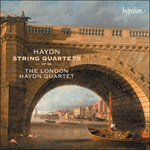
Welcome to Hyperion Records, a British classical label devoted to presenting high-quality recordings of music of all styles and from all periods from the twelfth century to the twenty-first.
Hyperion offers both CDs, and downloads in a number of formats. The site is also available in several languages.
Please use the dropdown buttons to set your preferred options, or use the checkbox to accept the defaults.

| The London Haydn Quartet» More |
The adagio cantabile, in A major, is a glowing meditation, somewhere between an aria and a hymn. The minor-keyed central section draws poignant new meanings from the theme, while the return of the major is a cue for expressive embellishments from the first violin. As so often in Haydn, the minuet combines a peasant earthiness with sophisticated motivic development. Its pervasive rising scale is taken up in the furtive D minor trio, initially in counterpoint to a traditional chromatic descending ‘ground bass’.
This irreverent use of a Baroque technique finds an echo in the airy fugato at the centre of the finale, a gossamer moto perpetuo that tests any quartet’s ability to play with extreme delicacy at speed. This irresistible music was surely the prototype for Mendelssohn’s famous ‘fairy scherzos’.
from notes by Richard Wigmore © 2018
L’adagio cantabile, en la majeur, est une brillante méditation, qui tient à la fois de l’aria et de l’hymne. La section centrale en mineur tire de nouvelles significations poignantes du thème, alors que le retour de la tonalité majeure est un signal pour des fioritures expressives du premier violon. Comme c’est souvent le cas chez Haydn, le menuet allie une truculence paysanne à un développement sophistiqué de motifs. Sa gamme ascendante omniprésente est reprise dans le furtif trio en ré mineur, initialement en contrepoint d’une «basse obstinée» chromatique descendante traditionnelle.
Cette utilisation irrévérencieuse d’une technique de l’ère baroque trouve un écho dans le fugato insouciant au milieu du finale, un moto perpetuo arachnéen qui teste la capacité du moindre quatuor à jouer à toute vitesse avec une extrême délicatesse. Cette musique irrésistible fut sûrement le prototype des célèbres «scherzos magiques» de Mendelssohn.
extrait des notes rédigées par Richard Wigmore © 2018
Français: Marie-Stella Pâris
Das Adagio cantabile in A-Dur bildet eine strahlende Meditation, irgendwo zwischen Arie und Hymnus. Der zentrale Moll-Abschnitt gewinnt dem Thema neue, schmerzliche Seiten ab; die Rückkehr nach Dur löst in der ersten Violine ausdrucksvolle Verzierungen aus. Das Menuett verbindet, wie so oft bei Haydns, erdige Ländlichkeit mit raffinierter Motivdurchführung. Die allgegenwärtige aufsteigende Tonleiter wird im Trio aufgegriffen, eingangs kontrapunktisch zu einem chromatisch absteigenden „passus-duriusculus“-Bass.
Dieser respektlose Anklang an barocke Satztechnik klingt auch in dem luftigen Fugato an, das im Zentrum des Finales steht. Dieses federleichte moto perpetuo stellt mit seiner Kombination aus Zartheit und Tempo das Können jedes Quartetts auf die Probe. Diese unwiderstehliche Musik stand sicher Pate für die späteren „Feenscherzi“ Mendelssohns.
aus dem Begleittext von Richard Wigmore © 2018
Deutsch: Friedrich Sprondel
 Haydn: String Quartets Op 64 Haydn: String Quartets Op 64The London Haydn Quartet’s recordings of their namesake continue to win universal plaudits. Those already familiar with some of the most stylish Haydn on record will need little prompting to acquire this highly desirable 2-for-1 album of the Op 64 ...» More |

